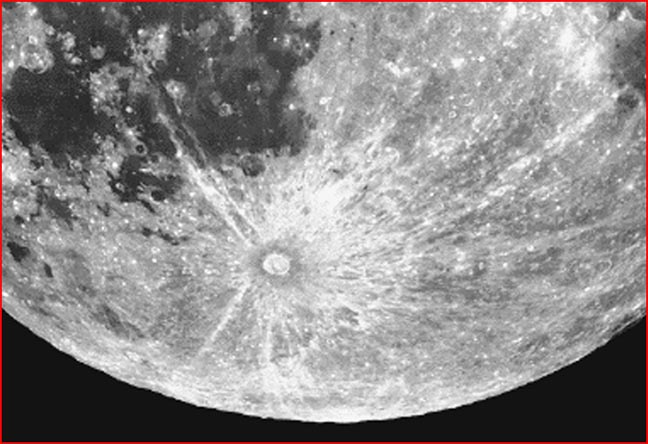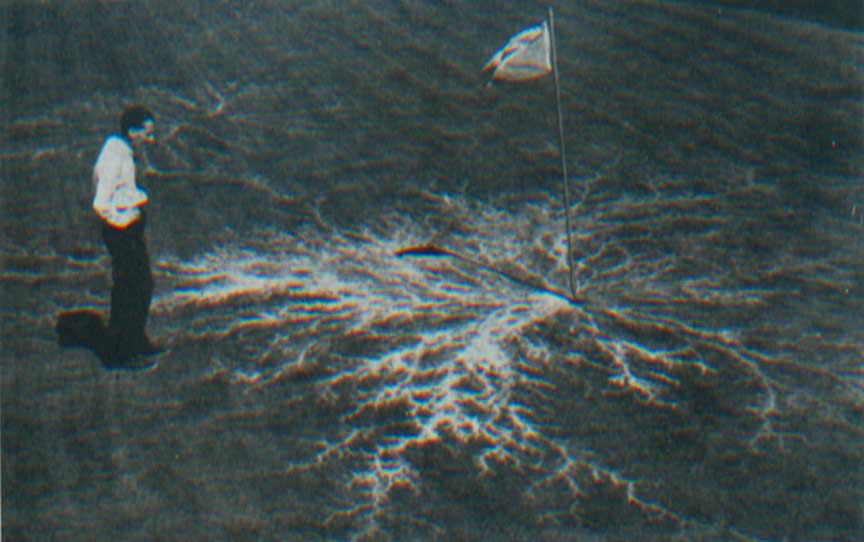That could be the answer. . . if space were crowded with dust. It isn't. However, Sake. either answer has to recognize that massive charges in space are the cause of the dust on the surface, which has been predicted by the EU cosmologists because it is a logical result of electrical machining that is also observable in the laboratory.
This may seem like an illogical jump, but consider the ejecta rays from what is assumed to be meteor impact crater Tyco on the Moon:

Tycho Crater
Notice anything odd? Almost every one of the ejecta rays is not a radii from the center of the impact! It seems as if they took a sharp turn after being ejected from the impact before leaving the vicinity of the crater. Why? How? What force caused that?
In any case, in the EU view, that ejecta is dust and particles from a bolt of lightning escaping from what has been mischaracterized as a meteor crater but what is actually an Electron Peak, formed by the rush of electrons build-up, as are the rays themselves, flowing toward the point of potential before discharge, before the initial bolt leaves, and the crater is the return strike.
When the brilliant engineer, Ralph Juergens, considered the lunar craters Tycho and Aristarchus, he noted the distinct features of electrical discharge. He wrote in 1974, “…If Aristarchus and Tycho were produced by electric discharges, their clean floors would be just about what one would expect. The abilities of discharges to produce melting on cathode [negatively charged] surfaces and generally to ‘clean up’ those surfaces have been remarked upon since the earliest experiments with electric discharges”.Then there is Crater Aristarchus, the second largest on the Moon, which is surrounded by a very strange ejecta field, that is anything but straight "spokes" radiating from a center crater.Juergens envisioned an interplanetary arc between the Moon and an approaching body (for his analysis, he summoned the planet Mars). While an instantaneous explosion does not have time to create a lava lake, an electric arc involving a long-distance flow of current between two approaching bodies, “would persist beyond the instant of any initial touchdown explosion”, leaving material melted in place.
Juergens saw Tycho as a “cathode crater”, and he drew special attention to Tycho’s “spectacular system of rays”. These, he suggested, are the very kind of streamers an electrical theorist would look for—a signature of the electron pathways that triggered the Tycho discharge.
Of course, the astronomers’ consensus today is that the streamers are the trails of material ejected from the crater into narrow paths over extraordinary distances. But the “rays”, Juergens noted, have no discernible depth, while material exploding from a Tycho-sized crater “would at least occasionally fall more heavily in one place than in another and build up substantial formations. But no one has ever been able to point out such a ray ‘deposit’”.
The presence of the narrow rays over such long distances, according to Juergens, is “all-but-impossible to reconcile with ejection origins. Enormous velocities of ejection must be postulated to explain the lengths of the rays, yet the energetic processes responsible for such velocities must be imagined to be focused very precisely to account for the ribbon-thin appearance of the rays”. In fact, this challenge has found no answer in more recent scientific exploration. No experimental explosion at any scale has ever produced anything comparable to the well-defined 1500-kilometer “rays” of Tycho. —Source

Aristarchus Crater (circled)
Look at this larger, over-all photo of the moon showing both craters with their surrounding fields, and then compare that surrounding field to this photograph of the aftermath of a lightning strike at a golf course:

Lightning Strike showing Lichtenberg figures of Electron paths
Lichtenberg figures are the twisting, contorted fractal pathways that electrons carve all the way down to the molecular level on their way of least resistance to escape during a cathode blister lightning strike. Most people think that lightning come down from the clouds, but the main bolt goes UP from the ground.
Look again at the two craters on the moon and you will see the Lichtenberg figures under the rays. . . they are far more obvious at Aristarchus.
The point is that as the electrons flow outward, they carry other material with them. This material having a lot more mass than an electron does fall eventually back around the point of ejection.